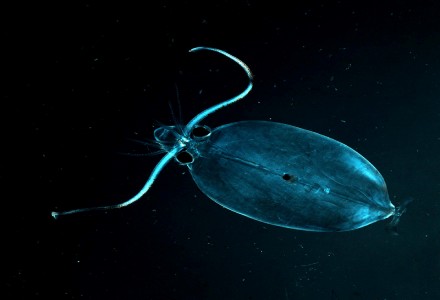
Glass Squid Facts
- Firstly, Glass Squid serves as the collective name for any species of squid in the Cranchiidae family. Further, scientists currently recognize 60 known species within this rather unique family.
- In addition, these creatures have evolved some astonishing characteristics. For example, some varieties also possess ammonia-filled sacs to aid in providing buoyancy.
- Further, as with most types of squid, individuals spend their youth living near the surface of the ocean. But, once reaching physical maturity, these slowly migrate to greater depths as they mature.
- Finally, and rather fortunately, the various types of Glass Squid appear to still exist in sufficient numbers. Therefore, the IUCN does not currently show any of them on its Red List of Threatened Species.
Related Articles
Sea Spider Yeti Crab Armhook Squid
Photo Credit: NOAA photo library
Public Domain Image
Squid Physical Description
Most notably, and not surprisingly, the various species of Glass Squid vary greatly in size. Some species possess a mantle length of as little as 3.9 in (4 cm). However, others among them measure as large as 9.8 ft (3 m).
Also, this cephalopod derives its common name from the transparent nature of the majority of the species in its family. This transparency also serves as excellent camouflage in the water.
Furthermore, the body generally appears quite puffy in shape. Also, of the eight arms, six stay comparatively short, while one pair grows longer. Additionally, many species of Glass Squid evolved to be bioluminescent, with the light-generating organs located beneath the eyes.
- Kingdom: Animalia
- Phylum: Mollusca
- Class: Cephalopoda
- Order: Oegopsida
- Family: Cranchiidae
Image Credit: NOAA photo library
Public Domain Image
Glass Squid Distribution, Habitat, and Ecology
First of all, the various Glass Squid have an incredible range of habitation. That’s because it lives in every ocean on earth. The majority of these creatures prefer a habitat region either near the surface or in mid-range depths.
However, there seem to be a few varieties of this incredible cephalopod that prefer a decidedly different habitat. These species prefer to reside at extreme depths of as much as 1.6 mi (2 km) below the surface.
In addition, like most related species, this carnivore primarily feeds on a rather wide variety of prey. This usually consists of various species of small fish, crabs, and similar-sized creatures.
Species Sharing Its Range
Fangtooth Gulper Eel Goblin Shark
Check out our other articles on 8 South American Geological Marvels, Gocta Cataracts, Thorny Dragon, Bosnian Pine, Black Rain Frog, Snow Leopard, Hyacinth Macaw

